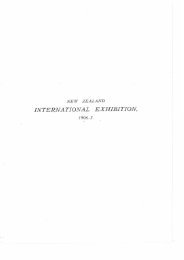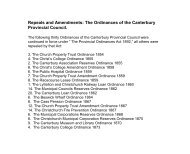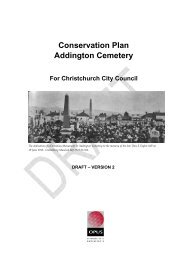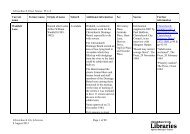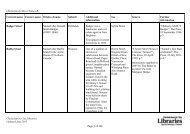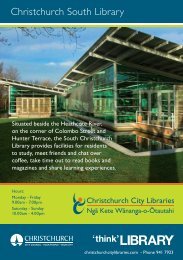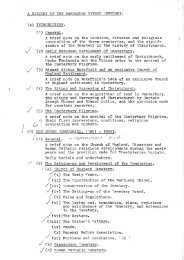Rich man, poor man, environmentalist, thief - Christchurch City ...
Rich man, poor man, environmentalist, thief - Christchurch City ...
Rich man, poor man, environmentalist, thief - Christchurch City ...
Create successful ePaper yourself
Turn your PDF publications into a flip-book with our unique Google optimized e-Paper software.
In <strong>Christchurch</strong>, Allan Hopkins had a career which took<br />
him from the shadows to riches and, after a spectacular<br />
crash, back into obscurity.<br />
When his children asked him about his origins, Allan replied<br />
airily that he was born at ‘Knock Castle’, was ‘the seventh<br />
son of a seventh son and born on New Year’s Day’. In reality,<br />
William Allan Hopkins was born at Cheadle, Staffordshire,<br />
England, on 31 December 1857, the son of John Hopkins and<br />
Mary Hopkins née Allan. He was baptised at St Giles’ Catholic<br />
church, Cheadle, which had been designed by famed architect<br />
Augustus Pugin. Despite this and the fact that he would<br />
describe his father as a contractor, he was nothing more than<br />
the second to youngest in a large struggling Irish family; a<br />
family indistinguishable from <strong>man</strong>y others which, both before<br />
and after the potato famine, emigrated to England in search of<br />
work. Early on, the younger Hopkins jettisoned the ‘William’<br />
and adopted the Irish custom of using, as his Christian name,<br />
his mother’s maiden name. Throughout his life, he was known<br />
as Allan Hopkins.<br />
In youth, Allan may have lived the harsh life of a ship’s<br />
cabin boy. Certainly, in 1881, he emigrated to Canterbury on<br />
the Lady Jocelyn. Boldly, the Catholic lad made himself known<br />
to a fellow passenger, a 17-year-old Wesleyan girl, Sarah Ann<br />
Roebuck, who was on a tour with her father and step-mother.<br />
William Roebuck, a woollen <strong>man</strong>ufacturer, consented to his<br />
daughter’s engagement and, on 11 February 1882, at the<br />
Durham Street Methodist church, the young couple were<br />
married. In May, in an attempt to secure his daughter’s future,<br />
William purchased property in association with his new sonin-law.<br />
Over a period of 16 years, seven children were born to<br />
Sarah and Allan: Serena or Scyrena, Luther, Daisy, Gertrude,<br />
Millicent, Dora and Allan junior.<br />
Allan dwelt at Madras Street and Office Road and worked<br />
as a builder, contractor and commission agent. By 1892 he<br />
was a ‘House, Land and Estate Agent, Valuator and Land<br />
Broker’ in Cathedral Square Chambers, a small rectangular<br />
building at 8 Cathedral Square. He was also at 133 Hereford<br />
Street. Adjacent to Allan’s business was the Bank of New<br />
Zealand. Allan leased but never owned this central city<br />
property.<br />
The Staffordshire lad enjoyed the trappings of status,<br />
including membership of the Masonic Lodge and, from about<br />
1912, the position of Justice of the Peace. It is surprising<br />
therefore that, in August 1889, he purchased 27 acres of sandy<br />
country in remote North New Brighton. Some of the land<br />
was on the south side of Travis Road in the area of the modern<br />
Wattle Drive but the larger block was to the north-east of the<br />
present Bower Avenue roundabout. This was considered<br />
‘not... a safe... but [rather]... a speculative district [with] neither<br />
beauty nor attraction’. The homestead,‘Saltaire’, on five acres<br />
to the north of Allan’s initial purchase, became ‘a showplace<br />
in the desert’. A land valuer would one day write that Allan’s<br />
improvements would ‘to most people… be money spent<br />
without discretion’. However, even he had to concede: ‘The<br />
grounds, certainly, are artistic’.<br />
In the early days, visitors knew they were nearing ‘Saltaire’<br />
when, at the corner of Racecourse Road (Bower Avenue) and<br />
Marriotts Road, they came upon a lamp stand which Allan<br />
had taken it upon himself to erect. When the original wooden<br />
structure was vandalised, Allan replaced it with a concrete<br />
stand. Throughout the years that the Hopkins family was<br />
domiciled at ‘Saltaire’, there lived with them Sarah’s maternal<br />
uncle, Matthew Henry Elam. For some time, it was Matthew’s<br />
job to light the lamp. A long asphalt drive wound up to the<br />
red pine rusticated weatherboard house which stood on a three<br />
Allan Hopkins<br />
(1857 – 1933)<br />
Sarah and Allan Hopkins<br />
35



